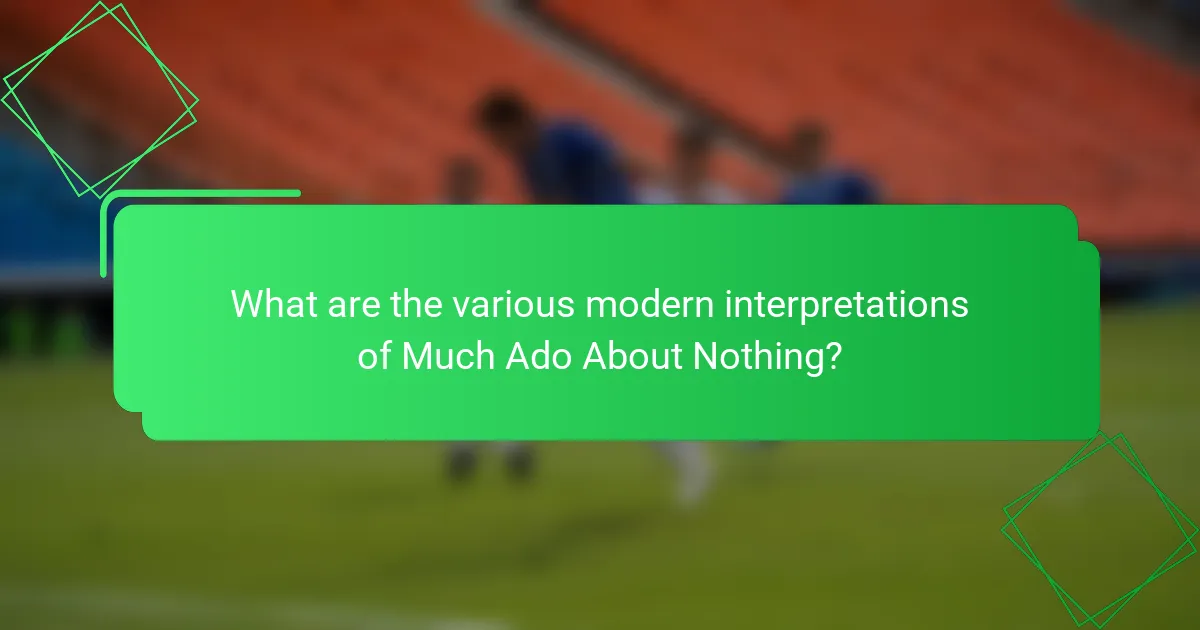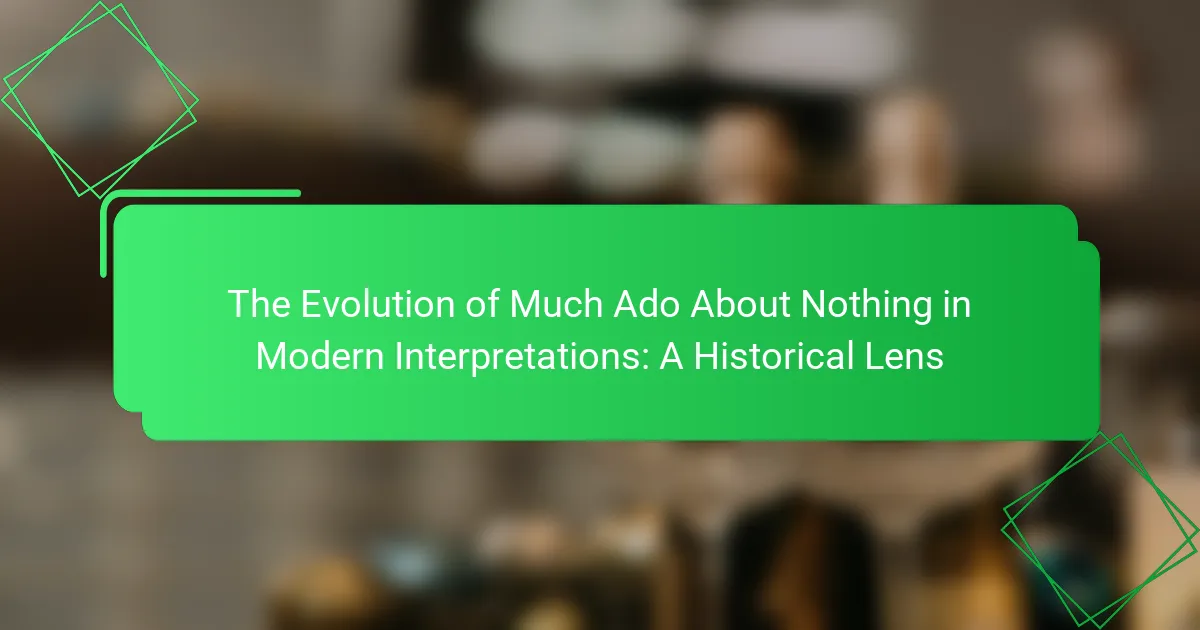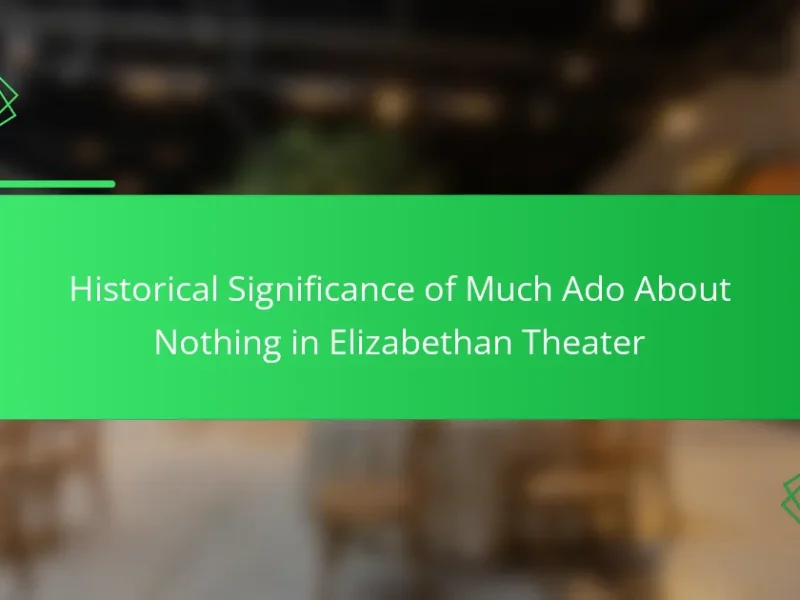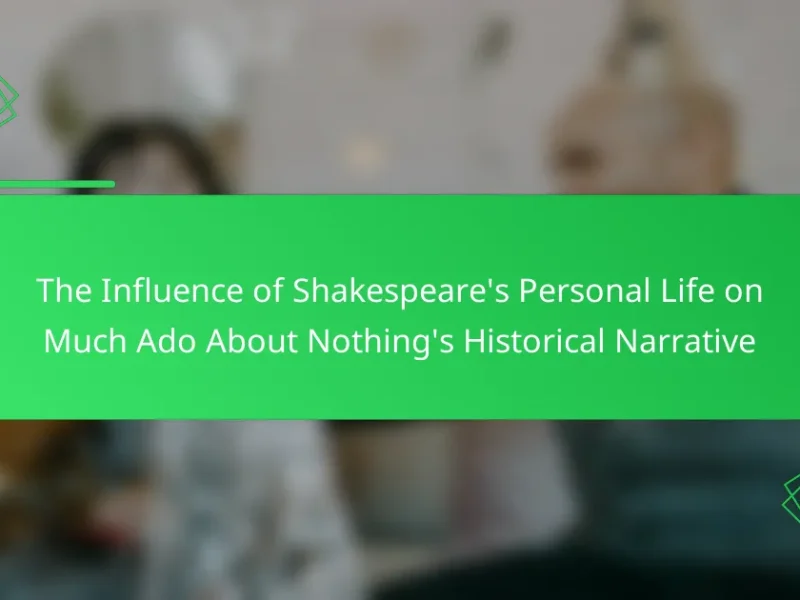
What is the significance of Much Ado About Nothing in modern interpretations?
Much Ado About Nothing is significant in modern interpretations for its exploration of gender dynamics and social norms. The play highlights issues of deception, love, and honor, which resonate with contemporary audiences. Modern adaptations often emphasize feminist perspectives, showcasing Beatrice’s strong character. This reflects current discussions on gender equality and women’s empowerment. Additionally, the play’s themes of misunderstanding and miscommunication are relevant in today’s digital age. Productions frequently use modern settings to make the story more relatable. This approach allows audiences to connect with the characters’ struggles in a familiar context. Overall, Much Ado About Nothing remains a vital commentary on human relationships and societal expectations.
How has Much Ado About Nothing been adapted in contemporary settings?
Much Ado About Nothing has been adapted in contemporary settings through various mediums and interpretations. Modern film adaptations, such as the 2012 version directed by Joss Whedon, set the play in a contemporary context while retaining original dialogue. Thematic elements have been updated to reflect current social issues, including gender dynamics and relationships. Stage productions often incorporate modern costumes and settings to resonate with today’s audiences. Some adaptations utilize technology, like social media, to enhance the narrative. Additionally, reinterpretations in diverse cultural contexts have emerged, showcasing the play’s universal themes. These adaptations demonstrate the play’s relevance and adaptability across time and culture.
What are the key themes explored in modern adaptations of Much Ado About Nothing?
Modern adaptations of Much Ado About Nothing explore themes such as love, deception, and gender roles. Love is central, often depicted through romantic misunderstandings and reconciliations. Deception plays a vital role, highlighting how lies and misunderstandings can impact relationships. Gender roles are frequently examined, showcasing the dynamics between men and women. These adaptations often reflect contemporary societal issues, such as feminism and the quest for identity. The theme of honor is also significant, particularly in how characters navigate societal expectations. Additionally, the exploration of friendship and loyalty is prevalent, emphasizing the bonds that form between characters. These themes resonate with modern audiences, making the play relevant across different contexts.
How do modern interpretations reflect societal changes since Shakespeare’s time?
Modern interpretations of Shakespeare’s works reflect societal changes by adapting themes to contemporary values. These adaptations often emphasize issues like gender equality and social justice. For example, modern productions of “Much Ado About Nothing” frequently highlight the empowerment of female characters. This shift aligns with the rise of feminist movements since Shakespeare’s era. Additionally, contemporary interpretations may alter character dynamics to reflect modern relationship norms. The portrayal of love and conflict often mirrors current societal discussions about consent and communication. Productions also utilize diverse casting to represent multicultural perspectives. This inclusivity contrasts sharply with the homogeneous casting of Shakespeare’s time. Overall, these changes showcase an evolving understanding of human experience and societal values.
Why is a historical lens important when analyzing Much Ado About Nothing?
A historical lens is important when analyzing Much Ado About Nothing because it provides context for the themes and characters. Understanding the Elizabethan era reveals societal norms regarding gender, marriage, and honor. These norms significantly influence character motivations and plot developments. For instance, the expectations of women in the 16th century shape Beatrice’s and Hero’s actions. Additionally, historical events, such as the rise of the middle class, inform the play’s social dynamics. This context enhances comprehension of the play’s commentary on love and deception. Analyzing the text through a historical lens deepens appreciation for Shakespeare’s critique of contemporary society.
What historical contexts influence the themes of Much Ado About Nothing?
Much Ado About Nothing is influenced by the historical context of the Elizabethan era. This period emphasized social hierarchies and gender roles. The play reflects the patriarchal society where women’s honor was paramount. Courtship and marriage were often transactional, highlighting economic factors in relationships. The play also critiques the concept of honor, particularly through the character of Claudio. Additionally, the influence of humanism is evident, showcasing individualism and personal agency. Political tensions in Italy during the Renaissance provide a backdrop for the play’s themes of deception and loyalty. These historical contexts shape the characters’ motivations and the play’s resolution.
How does understanding Shakespeare’s era enhance our interpretation of the play?
Understanding Shakespeare’s era enhances our interpretation of the play by providing crucial context. The social, political, and cultural dynamics of the Elizabethan period influence character motivations and themes. For instance, gender roles were strictly defined during this time. This context helps us understand the behavior of characters like Beatrice and Benedick. Additionally, the historical backdrop of the play’s setting informs our perception of honor and reputation. The significance of marriage in Elizabethan society shapes the plot’s conflicts. Understanding these elements allows for a deeper analysis of the play’s commentary on love and societal expectations. Historical events, such as the rise of the middle class, also impact character interactions. Thus, knowledge of Shakespeare’s time enriches our overall comprehension of “Much Ado About Nothing.”

What are the various modern interpretations of Much Ado About Nothing?
Modern interpretations of Much Ado About Nothing vary widely. Productions often emphasize themes of gender dynamics and social commentary. For instance, some adaptations portray Beatrice as a feminist icon. This highlights her assertiveness and independence. Other interpretations focus on the comedic elements, showcasing the play’s humor in contemporary settings.
Film adaptations, like Joss Whedon’s 2012 version, set the story in modern times while retaining original dialogue. This approach makes the characters relatable to today’s audience. Additionally, various stage productions have experimented with diverse casting. This brings new perspectives to the characters and their relationships.
Overall, these interpretations reflect shifting societal values and cultural contexts. They demonstrate the play’s enduring relevance across different eras.
How do directors approach the play in different cultural contexts?
Directors approach the play “Much Ado About Nothing” by adapting its themes and characters to resonate with specific cultural contexts. They consider local societal norms and values when interpreting the play. For example, in cultures that prioritize community, directors may emphasize collective relationships over individual motives.
Directors also modify dialogue and settings to reflect cultural nuances. In some adaptations, traditional costumes are used to connect with local audiences. Others may incorporate local dialects or languages to enhance relatability.
Cultural context influences the portrayal of gender roles in the play. In more progressive societies, directors might highlight themes of female empowerment. Conversely, in conservative cultures, traditional gender dynamics may be more pronounced.
Directors draw from historical influences relevant to the cultural context. For instance, adaptations in post-colonial societies may reflect themes of power and resistance. This approach allows audiences to engage with the play on a deeper level.
Overall, the cultural context shapes how directors interpret and present “Much Ado About Nothing,” making each version unique and relevant to its audience.
What are some notable film adaptations of Much Ado About Nothing?
Notable film adaptations of Much Ado About Nothing include the 1993 version directed by Kenneth Branagh. This adaptation features a star-studded cast including Denzel Washington and Emma Thompson. Another significant version is the 2012 adaptation directed by Joss Whedon. Whedon’s film was shot in black and white and set in a contemporary context. Additionally, the 1984 adaptation directed by David O. Russell is recognized for its unique interpretation. Each of these adaptations showcases the versatility of Shakespeare’s play across different styles and eras.
How do stage productions reinterpret the characters and settings?
Stage productions reinterpret characters and settings by altering their portrayal and context. Directors often emphasize contemporary themes to resonate with modern audiences. This can involve changing character motivations or relationships to reflect current social issues. For example, Beatrice and Benedick may be depicted as more empowered individuals in a feminist context. Settings can also be modernized, shifting from the original Italian backdrop to urban environments. Such changes create a fresh narrative that maintains the core story while making it relevant today. This approach has been noted in various adaptations, such as the 2012 film version directed by Joss Whedon, which set the play in a modern-day context while preserving Shakespeare’s dialogue.
What role do actors play in shaping modern interpretations of Much Ado About Nothing?
Actors play a crucial role in shaping modern interpretations of Much Ado About Nothing. Their performances influence audience perceptions and emotional responses. By embodying characters, actors bring new dimensions to Shakespeare’s text. This allows for contemporary relevance and relatability. Directors often collaborate with actors to explore innovative interpretations. The actors’ choices in delivery, tone, and physicality can shift the play’s themes. Notable adaptations showcase actors interpreting the characters in diverse cultural contexts. This adaptability helps keep the play alive in modern discourse.
How do casting choices impact audience perception of the characters?
Casting choices significantly influence audience perception of characters. The actors’ physical appearance, ethnicity, and prior roles shape how viewers interpret characters’ motivations and traits. For instance, a well-known actor may bring preconceived notions based on their past performances. This can lead to a more immediate connection or disconnection with the character being portrayed. In “Much Ado About Nothing,” casting a contemporary actor can modernize the character’s appeal, making them more relatable to today’s audience. Research indicates that diverse casting can enhance audience engagement by reflecting societal changes and promoting inclusivity. Thus, casting is a critical element in shaping how characters are perceived and understood by the audience.
What techniques do actors use to connect with contemporary audiences?
Actors use techniques such as emotional authenticity, relatable character portrayals, and modern language adaptations to connect with contemporary audiences. Emotional authenticity involves conveying genuine feelings that resonate with viewers. Relatable character portrayals make characters more accessible, allowing audiences to see themselves in the roles. Modern language adaptations help bridge the gap between Shakespearean dialogue and contemporary vernacular. These techniques enhance audience engagement. Research indicates that productions that implement these strategies often see increased audience appreciation and understanding. For example, a study by the Royal Shakespeare Company found that modernized adaptations led to a 30% increase in audience enjoyment.

How does Much Ado About Nothing remain relevant in today’s society?
Much Ado About Nothing remains relevant in today’s society due to its exploration of themes like love, deception, and social dynamics. These themes resonate with contemporary audiences facing similar relational challenges. The play’s witty dialogue and complex characters reflect human behavior that transcends time. Modern adaptations often highlight issues such as gender roles and societal expectations. For instance, productions may emphasize the power dynamics between men and women, making the narrative relatable to current discussions on equality. Additionally, the humor in the play continues to engage audiences, making it a staple in both academic and entertainment contexts. Its adaptability allows for various interpretations that align with current societal values and issues.
What lessons can modern audiences learn from Much Ado About Nothing?
Modern audiences can learn about the complexities of love and relationships from Much Ado About Nothing. The play illustrates misunderstandings and miscommunications that can arise in romantic contexts. Characters like Beatrice and Benedick showcase how wit can mask deeper feelings. The theme of deception highlights the consequences of trust and betrayal. Additionally, the play emphasizes the importance of honesty in relationships. It also reflects societal expectations of gender roles during Shakespeare’s time. These lessons remain relevant today as they resonate with contemporary relationship dynamics. The exploration of loyalty and friendship further enriches the narrative’s relevance.
How do the play’s conflicts resonate with current social issues?
The conflicts in “Much Ado About Nothing” resonate with current social issues such as gender roles and the impact of misinformation. The play’s exploration of honor and reputation reflects ongoing discussions about societal expectations for men and women. For instance, the character of Hero faces public shaming based on false accusations, paralleling contemporary issues of online harassment and the consequences of misinformation. Additionally, the play’s comedic yet critical lens on romantic relationships highlights the complexities of consent and communication, which are central to modern conversations about these topics. Such themes continue to be relevant, as they mirror the struggles individuals face in navigating societal pressures and personal integrity today.
What messages about love and relationships are still applicable today?
Messages about love and relationships that remain applicable today include the importance of communication and trust. Effective communication fosters understanding and connection between partners. Trust serves as the foundation for a healthy relationship. Additionally, the value of overcoming misunderstandings is evident in many relationships. Miscommunication can lead to conflict, but resolution can strengthen bonds. The significance of loyalty and commitment also endures. Relationships thrive when both partners are dedicated to each other. Furthermore, the idea that love requires effort and nurturing is timeless. Relationships need ongoing care to flourish. These messages reflect enduring truths about human connections that resonate across generations.
What are some best practices for studying Much Ado About Nothing through a historical lens?
Best practices for studying Much Ado About Nothing through a historical lens include contextualizing the text within its Elizabethan era. Understanding the social norms, gender roles, and political dynamics of the 16th century is essential. Analyzing contemporary literature and theater can provide insight into Shakespeare’s influences. Exploring historical events that parallel the play’s themes enhances comprehension. Utilizing scholarly resources, such as historical critiques and biographies of Shakespeare, enriches analysis. Engaging with primary sources from the period can reveal audience perceptions and expectations. Lastly, participating in discussions or seminars focused on historical interpretations fosters deeper understanding.
How can readers analyze the text with a focus on historical context?
Readers can analyze the text by examining the historical context in which it was written. This involves researching the social, political, and cultural conditions of the time. Understanding the Elizabethan era enhances comprehension of themes and character motivations. For instance, gender roles and class distinctions were significant during Shakespeare’s time. Analyzing these aspects reveals deeper meanings in the dialogue and actions of characters. Historical events, such as the influence of the monarchy, also shape the narrative. Readers can compare contemporary issues with those presented in the text. This comparison highlights the text’s relevance across time periods. Additionally, consulting scholarly interpretations can provide insights into historical influences on the narrative.
What resources are available for deeper exploration of Much Ado About Nothing?
Scholarly articles and books are available for deeper exploration of Much Ado About Nothing. The Folger Shakespeare Library offers extensive resources, including critical essays and historical context. JSTOR provides access to peer-reviewed articles on various interpretations. The Cambridge University Press publishes comprehensive analyses of Shakespeare’s works. Online platforms like Project Gutenberg have free texts of the play. Additionally, the Royal Shakespeare Company’s website features insights into performances and adaptations. These resources enhance understanding of the play’s evolution and modern interpretations.
Much Ado About Nothing serves as the primary entity explored in this article, focusing on its modern interpretations through a historical lens. The article examines the play’s significance in contemporary contexts, highlighting themes of gender dynamics, deception, and social norms that resonate with today’s audiences. It discusses various adaptations across film and stage, emphasizing the relevance of its themes to current societal issues. Additionally, the article analyzes how historical contexts influence character motivations and the portrayal of relationships, offering insights into the play’s ongoing impact and adaptability.


